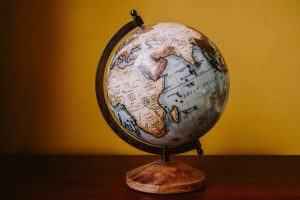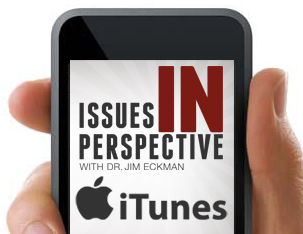The Confusing World Order Of 2025
Jan 11th, 2025 | By Dr. Jim Eckman | Category: Featured Issues, Politics & Current EventsThe mission of Issues in Perspective is to provide thoughtful, historical and biblically-centered perspectives on current ethical and cultural issues.

In the 1930s, the United States pursued a policy of protectionism and isolationism. “No coincidence, World War II soon followed.” Germany’s and Japan’s neighbors were too weak to deter and defeat those fascist dictatorships on their own. They desperately needed American help, and they did not receive it until it was nearly too late. Max Boot argues that “After 1945 in the United States, the greatest generation sought to rectify that mistake by constructing a new world order based on free-trade pacts and security alliances. That approach was staggeringly successful: Democracy and prosperity spread around the world. Great power conflict has been averted. The United States has been the biggest beneficiary among major nations of the international system that it created along with its allies: U.S. gross domestic product per capita in 2023 was $73,600, compared with just $39,800 for Russia and $22,100 for China.”
Furthermore, with the collapse of the Soviet Union in 1991, America emerged as the first and only global superpower. America therefore championed the values of democracy, open markets, human rights and the rule of law—and it had the clout of both military and financial power to impose this moral code on terrorists and tyrants. The result was a period of peace, prosperity and progress. But that world order championed by the US is breaking down. Yet, the United States remains by far by the most powerful country in the world: It spends more on defense than the next 10 countries combined, and its economic output accounts for roughly one-quarter of the global total. “What America does matters. A lot.”
But, how do Vladimir Putin and Xi Jinping view the United States and the larger West? Historian Mikhail Zygar demonstrates that “The idea that the United States is entering the final stage of its history has been kicking around Russia for some time. For years, it was confined to fringe voices. But since around 2020, figures from the Kremlin have been making the argument, too. Leading the charge was Nikolai Patrushev, a former director of the Federal Security Service and one of Mr. Putin’s key advisers. Widely regarded as Russia’s leading hard-liner, he was among the first to claim that America was on an inexorable path to implosion . . . Mr. Putin himself had laid out a similar view of territorial disintegration. ‘As a former citizen of the former Soviet Union, I’ll tell you the problem with empires: They believe they are so powerful that they can afford minor mistakes,’ he said in 2021. ‘But the problems accumulate, and a moment comes when they are no longer manageable. The United States is confidently, firmly marching down the same path as the Soviet Union.’ This still seems to represent Mr. Putin’s fundamental assessment of the country. He is convinced that America is nearing its end.”
Zygar continues, “In this worldview, liberal ideology in the United States—encompassing not just progressive values but also the promotion of democracy and human rights abroad—has become like communist ideology in the late Soviet Union. Fewer and fewer people believe in it, more and more find it absurd, and many increasingly lean toward a much more cynical perspective. To the Kremlin, the Democratic Party has become excessively dogmatic, resembling the Communist Party of the Soviet Union in its final decade: an arrogant steward of a bankrupt belief system, stumbling toward a fall . . . Of course, much of this is wishful thinking. Predictions of America’s imminent collapse have no basis in reality. The Soviet Union fell because it bankrupted itself under the weight of excessive military spending and imperial ambitions. Its economy proved to be unsustainable and ethnic tensions emerged, with some Soviet republics pushing for independence.”
Edward Carr, Deputy Editor of The Economist, makes this astute observation about Putin: “After the collapse of the Soviet Union, Russia discovered that it could not thrive in the ordered, democratic, American-led world. The only way for Russia to claim its place among the great powers is to destroy the foundations of that order, including NATO, the European Union and the credibility of Western democracies. For Europe, therefore, the stakes are existential.”
Xi Jinping posits a similar view of the West. He sees powerful forces leading to the decline of the West and the ineluctable rise of the East. As The Economist observes, “This process can be hastened by a disciplined Communist Party that understands the dialectical process.” Xi advocates for “the great rejuvenation of the Chinese nation” by 2049, when the party marks the centenary of its rule. One of its defining objectives of this “rejuvenation” is “reunification” with Taiwan.
Putin’s invasion of Ukraine has brought all of this to the forefront. Given Putin’s worldview, Ukraine has showed him two things: [1] The West is unwilling to give Ukraine enough money and weapons to defend itself. [2] The West has failed to stop Russia in its objective of stopping Ukraine from joining NATO and slowly gaining control of 20% of Ukraine. As Carr argues, “[Putin] will rightly surmise that Europe is too weak-willed and complacent to face the changing geopolitical reality. If he concludes that he has more chances to disrupt NATO, his behavior will become yet more aggressive.” The frontiers of northern and eastern Europe are next.
Walter Russell Mead contends that Putin has three objectives from the Ukraine war: As much of Ukraine’s territory and population as he can conquer; Russian veto power over the foreign and economic policy of what is left of Ukraine after the war; and a substantial weakening of both NATO and the EU. “Although the costs are high, every day of the war brings Putin closer to all three objectives. These three objectives will be at the center of any negotiations the future Trump administration will try to orchestrate.
With the election of Donald Trump, it appears that America will once again slip into policies of protectionism and isolationism. If true, is Europe prepared for this “existential” threat posed by Putin’s view of the West? As we begin 2025, Europe is not stable and not ready to defend itself against an increasingly aggressive Russia. There are several concerns here:
- The problem of resources. As Shashank Joshi, Defense Editor of The Economist, shows, only about two-thirds of NATO’s 30 European members currently spend 2% of GDP on defense. “Without America, they would need to spend perhaps twice that to have any hope of filling the resulting military gaps . . . And it would take years . . . to rebuild defense industries.”
- Europe will also need to decide whether to reorganize the basis of their collective defense. Today, Europe has prioritized NATO, while also expanding security and defense capabilities in the EU. But the EU does not include Great Britain. So, if NATO is deemphasized due to Trump’s policies, what does Europe do? And it is also important to remember that there are only two nuclear powers in Europe—Britain and France.
- Seeing a peace agreement or ceasefire in Ukraine will prove very divisive in Europe. The northern, central and eastern European countries will fight back any American efforts to impose a bad deal on Ukraine. But this “hawkish” bloc does not have the resources or industrial capacity to keep Ukraine supplied, let alone substitute for American military power in Europe. Therefore, the role of Britain, France and Germany will remain crucial. But, as Carr shows, Germany is tearing itself apart; France has a minority government surviving at the behest of pro-Russian Marine Le Pen; and Britain is now governed by an inexperienced Labor government.
In short, Europe needs to build its own deterrent force against Putin. If Europe acquiesces to Putin, due to a Trump peace proposal, it will grant him a partial victory, give him time to rebuild his forces and agree “to live with a new iron curtain—or under the shadow of another war.” Will history repeat itself? Are we now entering a period somewhat similar to the 1930s? Are the policies of protectionism and isolationism a genuine threat to world stability? Only the Lord knows.
See Max Boot in the Washington Post (21 October 2024); Mikhail Zygar in the New York Times (24 November 2024); The Economist (23 November 2024), pp. 34-35; Edward Carr in The World Ahead 2025, p. 11; Walter Russell Mead in the Wall Street Journal (22 October 2024); and Shashank Joshi in The World Ahead 2025, pp. 63-64.


